ACC511 - Managerial Finance: Project Evaluation for Dell Inc.
VerifiedAdded on 2022/11/14
|9
|1857
|331
Report
AI Summary
This report provides a comprehensive financial analysis of a proposed manufacturing plant project by Dell Inc. The report evaluates the project's feasibility using Net Present Value (NPV), Internal Rate of Return (IRR), and payback period methods. It includes detailed calculations for cash flows, depreciation, and discount rates to determine the project's profitability and investment viability. The report also considers a new financial discipline adopted by the company and assesses the maximum interest rate the company can afford. Furthermore, the report presents the pros and cons of the new financial requirements. The analysis concludes with recommendations on whether Dell should proceed with the project, based on the financial metrics and the new financial discipline.

Running head: MANAGERIAL FINANCE
Managerial finance
Name of the student
Name of the university
Student ID
Author note
Managerial finance
Name of the student
Name of the university
Student ID
Author note
Paraphrase This Document
Need a fresh take? Get an instant paraphrase of this document with our AI Paraphraser

1MANAGERIAL FINANCE
Executive summary
Aim of the report is to analyse one manufacturing project that is planned by Dell to be started
in near future. However, the company wants to evaluate the project in context of its
profitability before investing the amount. Different methods those will be used for the
project’s analysis are NPV approach, IRR and payback period. In addition to that the project
will be evaluated based on the new financial discipline adopted by it.
Executive summary
Aim of the report is to analyse one manufacturing project that is planned by Dell to be started
in near future. However, the company wants to evaluate the project in context of its
profitability before investing the amount. Different methods those will be used for the
project’s analysis are NPV approach, IRR and payback period. In addition to that the project
will be evaluated based on the new financial discipline adopted by it.
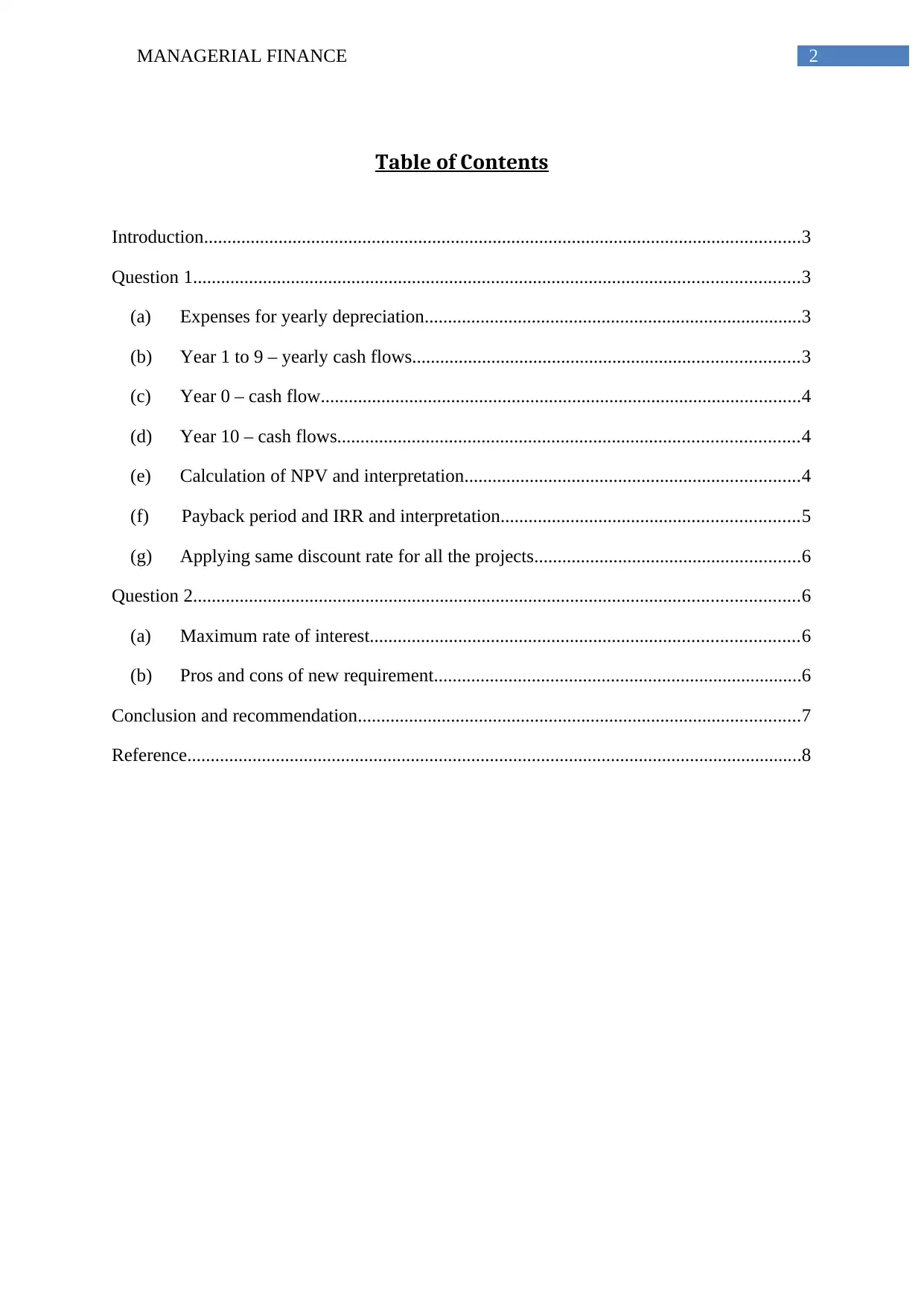
2MANAGERIAL FINANCE
Table of Contents
Introduction................................................................................................................................3
Question 1..................................................................................................................................3
(a) Expenses for yearly depreciation.................................................................................3
(b) Year 1 to 9 – yearly cash flows...................................................................................3
(c) Year 0 – cash flow.......................................................................................................4
(d) Year 10 – cash flows...................................................................................................4
(e) Calculation of NPV and interpretation........................................................................4
(f) Payback period and IRR and interpretation................................................................5
(g) Applying same discount rate for all the projects.........................................................6
Question 2..................................................................................................................................6
(a) Maximum rate of interest............................................................................................6
(b) Pros and cons of new requirement...............................................................................6
Conclusion and recommendation...............................................................................................7
Reference....................................................................................................................................8
Table of Contents
Introduction................................................................................................................................3
Question 1..................................................................................................................................3
(a) Expenses for yearly depreciation.................................................................................3
(b) Year 1 to 9 – yearly cash flows...................................................................................3
(c) Year 0 – cash flow.......................................................................................................4
(d) Year 10 – cash flows...................................................................................................4
(e) Calculation of NPV and interpretation........................................................................4
(f) Payback period and IRR and interpretation................................................................5
(g) Applying same discount rate for all the projects.........................................................6
Question 2..................................................................................................................................6
(a) Maximum rate of interest............................................................................................6
(b) Pros and cons of new requirement...............................................................................6
Conclusion and recommendation...............................................................................................7
Reference....................................................................................................................................8
⊘ This is a preview!⊘
Do you want full access?
Subscribe today to unlock all pages.

Trusted by 1+ million students worldwide
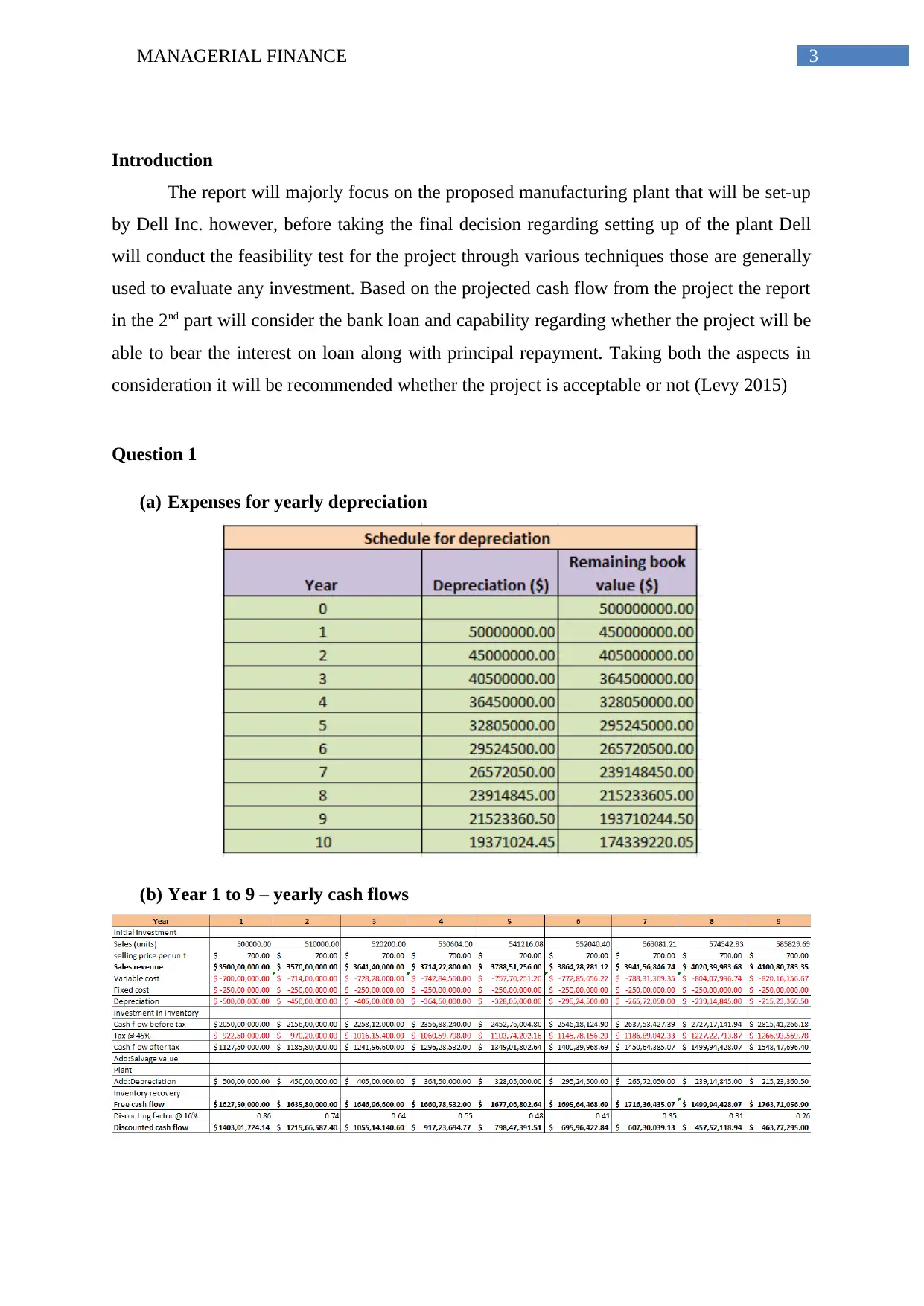
3MANAGERIAL FINANCE
Introduction
The report will majorly focus on the proposed manufacturing plant that will be set-up
by Dell Inc. however, before taking the final decision regarding setting up of the plant Dell
will conduct the feasibility test for the project through various techniques those are generally
used to evaluate any investment. Based on the projected cash flow from the project the report
in the 2nd part will consider the bank loan and capability regarding whether the project will be
able to bear the interest on loan along with principal repayment. Taking both the aspects in
consideration it will be recommended whether the project is acceptable or not (Levy 2015)
Question 1
(a) Expenses for yearly depreciation
(b) Year 1 to 9 – yearly cash flows
Introduction
The report will majorly focus on the proposed manufacturing plant that will be set-up
by Dell Inc. however, before taking the final decision regarding setting up of the plant Dell
will conduct the feasibility test for the project through various techniques those are generally
used to evaluate any investment. Based on the projected cash flow from the project the report
in the 2nd part will consider the bank loan and capability regarding whether the project will be
able to bear the interest on loan along with principal repayment. Taking both the aspects in
consideration it will be recommended whether the project is acceptable or not (Levy 2015)
Question 1
(a) Expenses for yearly depreciation
(b) Year 1 to 9 – yearly cash flows
Paraphrase This Document
Need a fresh take? Get an instant paraphrase of this document with our AI Paraphraser
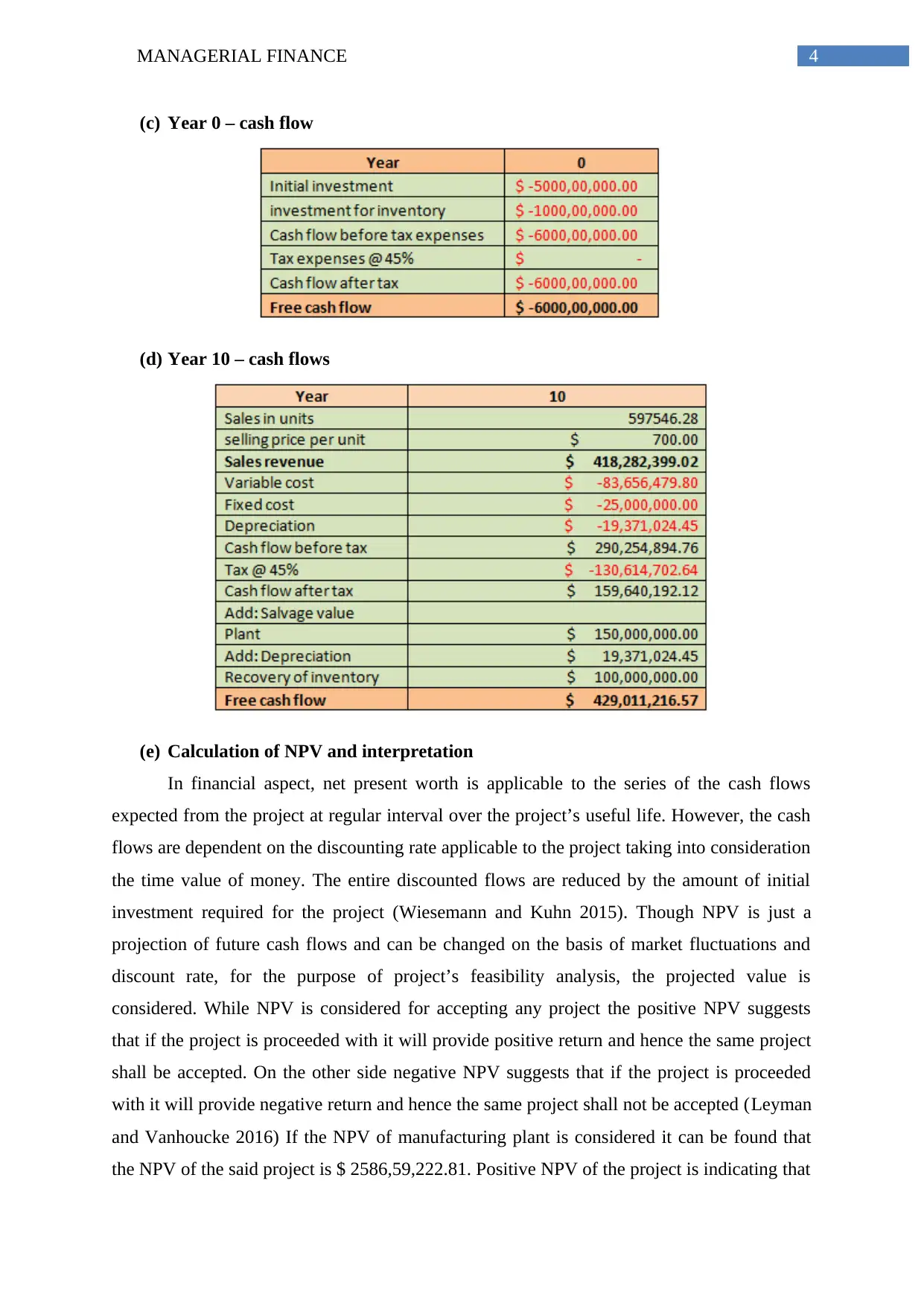
4MANAGERIAL FINANCE
(c) Year 0 – cash flow
(d) Year 10 – cash flows
(e) Calculation of NPV and interpretation
In financial aspect, net present worth is applicable to the series of the cash flows
expected from the project at regular interval over the project’s useful life. However, the cash
flows are dependent on the discounting rate applicable to the project taking into consideration
the time value of money. The entire discounted flows are reduced by the amount of initial
investment required for the project (Wiesemann and Kuhn 2015). Though NPV is just a
projection of future cash flows and can be changed on the basis of market fluctuations and
discount rate, for the purpose of project’s feasibility analysis, the projected value is
considered. While NPV is considered for accepting any project the positive NPV suggests
that if the project is proceeded with it will provide positive return and hence the same project
shall be accepted. On the other side negative NPV suggests that if the project is proceeded
with it will provide negative return and hence the same project shall not be accepted (Leyman
and Vanhoucke 2016) If the NPV of manufacturing plant is considered it can be found that
the NPV of the said project is $ 2586,59,222.81. Positive NPV of the project is indicating that
(c) Year 0 – cash flow
(d) Year 10 – cash flows
(e) Calculation of NPV and interpretation
In financial aspect, net present worth is applicable to the series of the cash flows
expected from the project at regular interval over the project’s useful life. However, the cash
flows are dependent on the discounting rate applicable to the project taking into consideration
the time value of money. The entire discounted flows are reduced by the amount of initial
investment required for the project (Wiesemann and Kuhn 2015). Though NPV is just a
projection of future cash flows and can be changed on the basis of market fluctuations and
discount rate, for the purpose of project’s feasibility analysis, the projected value is
considered. While NPV is considered for accepting any project the positive NPV suggests
that if the project is proceeded with it will provide positive return and hence the same project
shall be accepted. On the other side negative NPV suggests that if the project is proceeded
with it will provide negative return and hence the same project shall not be accepted (Leyman
and Vanhoucke 2016) If the NPV of manufacturing plant is considered it can be found that
the NPV of the said project is $ 2586,59,222.81. Positive NPV of the project is indicating that
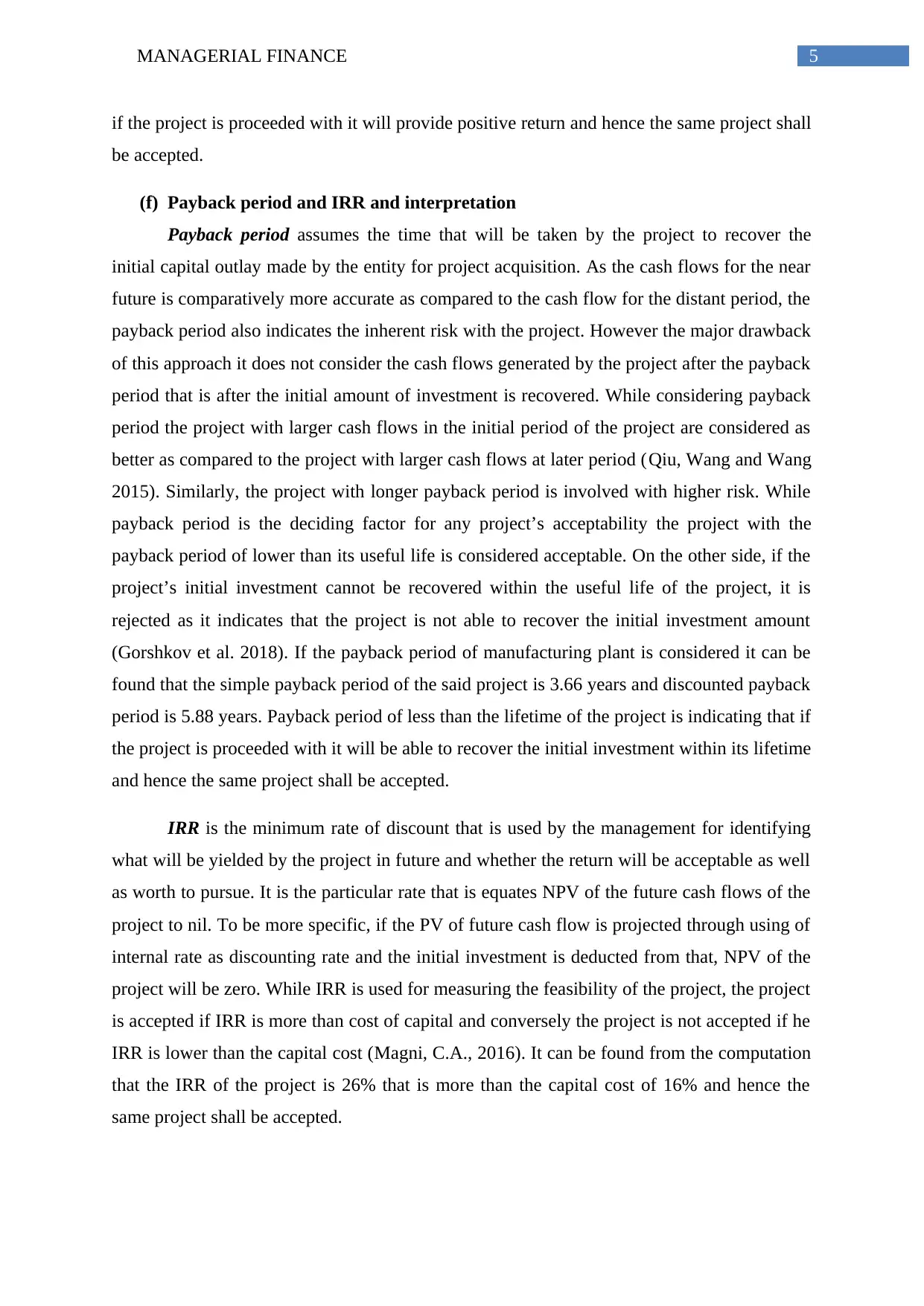
5MANAGERIAL FINANCE
if the project is proceeded with it will provide positive return and hence the same project shall
be accepted.
(f) Payback period and IRR and interpretation
Payback period assumes the time that will be taken by the project to recover the
initial capital outlay made by the entity for project acquisition. As the cash flows for the near
future is comparatively more accurate as compared to the cash flow for the distant period, the
payback period also indicates the inherent risk with the project. However the major drawback
of this approach it does not consider the cash flows generated by the project after the payback
period that is after the initial amount of investment is recovered. While considering payback
period the project with larger cash flows in the initial period of the project are considered as
better as compared to the project with larger cash flows at later period (Qiu, Wang and Wang
2015). Similarly, the project with longer payback period is involved with higher risk. While
payback period is the deciding factor for any project’s acceptability the project with the
payback period of lower than its useful life is considered acceptable. On the other side, if the
project’s initial investment cannot be recovered within the useful life of the project, it is
rejected as it indicates that the project is not able to recover the initial investment amount
(Gorshkov et al. 2018). If the payback period of manufacturing plant is considered it can be
found that the simple payback period of the said project is 3.66 years and discounted payback
period is 5.88 years. Payback period of less than the lifetime of the project is indicating that if
the project is proceeded with it will be able to recover the initial investment within its lifetime
and hence the same project shall be accepted.
IRR is the minimum rate of discount that is used by the management for identifying
what will be yielded by the project in future and whether the return will be acceptable as well
as worth to pursue. It is the particular rate that is equates NPV of the future cash flows of the
project to nil. To be more specific, if the PV of future cash flow is projected through using of
internal rate as discounting rate and the initial investment is deducted from that, NPV of the
project will be zero. While IRR is used for measuring the feasibility of the project, the project
is accepted if IRR is more than cost of capital and conversely the project is not accepted if he
IRR is lower than the capital cost (Magni, C.A., 2016). It can be found from the computation
that the IRR of the project is 26% that is more than the capital cost of 16% and hence the
same project shall be accepted.
if the project is proceeded with it will provide positive return and hence the same project shall
be accepted.
(f) Payback period and IRR and interpretation
Payback period assumes the time that will be taken by the project to recover the
initial capital outlay made by the entity for project acquisition. As the cash flows for the near
future is comparatively more accurate as compared to the cash flow for the distant period, the
payback period also indicates the inherent risk with the project. However the major drawback
of this approach it does not consider the cash flows generated by the project after the payback
period that is after the initial amount of investment is recovered. While considering payback
period the project with larger cash flows in the initial period of the project are considered as
better as compared to the project with larger cash flows at later period (Qiu, Wang and Wang
2015). Similarly, the project with longer payback period is involved with higher risk. While
payback period is the deciding factor for any project’s acceptability the project with the
payback period of lower than its useful life is considered acceptable. On the other side, if the
project’s initial investment cannot be recovered within the useful life of the project, it is
rejected as it indicates that the project is not able to recover the initial investment amount
(Gorshkov et al. 2018). If the payback period of manufacturing plant is considered it can be
found that the simple payback period of the said project is 3.66 years and discounted payback
period is 5.88 years. Payback period of less than the lifetime of the project is indicating that if
the project is proceeded with it will be able to recover the initial investment within its lifetime
and hence the same project shall be accepted.
IRR is the minimum rate of discount that is used by the management for identifying
what will be yielded by the project in future and whether the return will be acceptable as well
as worth to pursue. It is the particular rate that is equates NPV of the future cash flows of the
project to nil. To be more specific, if the PV of future cash flow is projected through using of
internal rate as discounting rate and the initial investment is deducted from that, NPV of the
project will be zero. While IRR is used for measuring the feasibility of the project, the project
is accepted if IRR is more than cost of capital and conversely the project is not accepted if he
IRR is lower than the capital cost (Magni, C.A., 2016). It can be found from the computation
that the IRR of the project is 26% that is more than the capital cost of 16% and hence the
same project shall be accepted.
⊘ This is a preview!⊘
Do you want full access?
Subscribe today to unlock all pages.

Trusted by 1+ million students worldwide
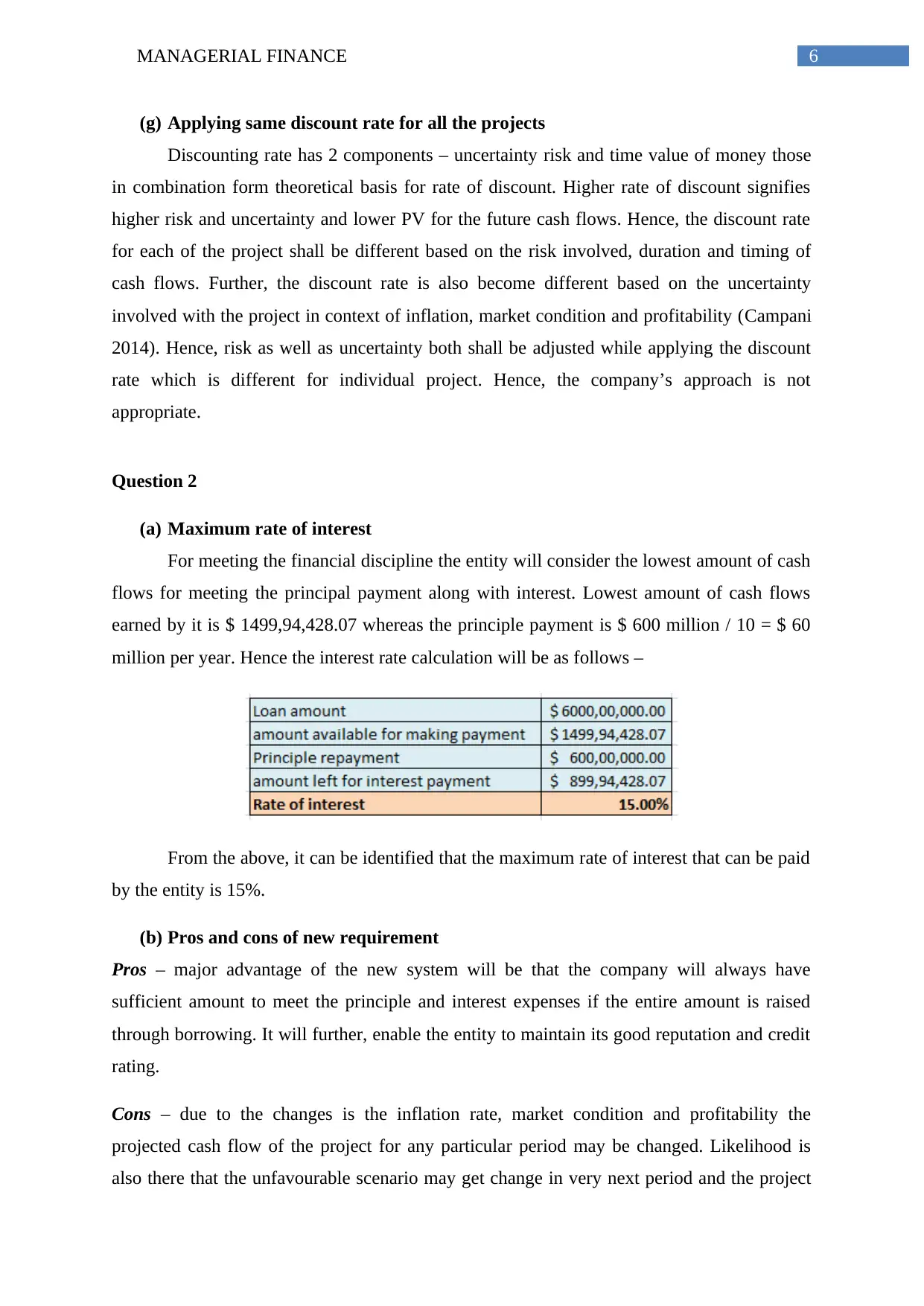
6MANAGERIAL FINANCE
(g) Applying same discount rate for all the projects
Discounting rate has 2 components – uncertainty risk and time value of money those
in combination form theoretical basis for rate of discount. Higher rate of discount signifies
higher risk and uncertainty and lower PV for the future cash flows. Hence, the discount rate
for each of the project shall be different based on the risk involved, duration and timing of
cash flows. Further, the discount rate is also become different based on the uncertainty
involved with the project in context of inflation, market condition and profitability (Campani
2014). Hence, risk as well as uncertainty both shall be adjusted while applying the discount
rate which is different for individual project. Hence, the company’s approach is not
appropriate.
Question 2
(a) Maximum rate of interest
For meeting the financial discipline the entity will consider the lowest amount of cash
flows for meeting the principal payment along with interest. Lowest amount of cash flows
earned by it is $ 1499,94,428.07 whereas the principle payment is $ 600 million / 10 = $ 60
million per year. Hence the interest rate calculation will be as follows –
From the above, it can be identified that the maximum rate of interest that can be paid
by the entity is 15%.
(b) Pros and cons of new requirement
Pros – major advantage of the new system will be that the company will always have
sufficient amount to meet the principle and interest expenses if the entire amount is raised
through borrowing. It will further, enable the entity to maintain its good reputation and credit
rating.
Cons – due to the changes is the inflation rate, market condition and profitability the
projected cash flow of the project for any particular period may be changed. Likelihood is
also there that the unfavourable scenario may get change in very next period and the project
(g) Applying same discount rate for all the projects
Discounting rate has 2 components – uncertainty risk and time value of money those
in combination form theoretical basis for rate of discount. Higher rate of discount signifies
higher risk and uncertainty and lower PV for the future cash flows. Hence, the discount rate
for each of the project shall be different based on the risk involved, duration and timing of
cash flows. Further, the discount rate is also become different based on the uncertainty
involved with the project in context of inflation, market condition and profitability (Campani
2014). Hence, risk as well as uncertainty both shall be adjusted while applying the discount
rate which is different for individual project. Hence, the company’s approach is not
appropriate.
Question 2
(a) Maximum rate of interest
For meeting the financial discipline the entity will consider the lowest amount of cash
flows for meeting the principal payment along with interest. Lowest amount of cash flows
earned by it is $ 1499,94,428.07 whereas the principle payment is $ 600 million / 10 = $ 60
million per year. Hence the interest rate calculation will be as follows –
From the above, it can be identified that the maximum rate of interest that can be paid
by the entity is 15%.
(b) Pros and cons of new requirement
Pros – major advantage of the new system will be that the company will always have
sufficient amount to meet the principle and interest expenses if the entire amount is raised
through borrowing. It will further, enable the entity to maintain its good reputation and credit
rating.
Cons – due to the changes is the inflation rate, market condition and profitability the
projected cash flow of the project for any particular period may be changed. Likelihood is
also there that the unfavourable scenario may get change in very next period and the project
Paraphrase This Document
Need a fresh take? Get an instant paraphrase of this document with our AI Paraphraser
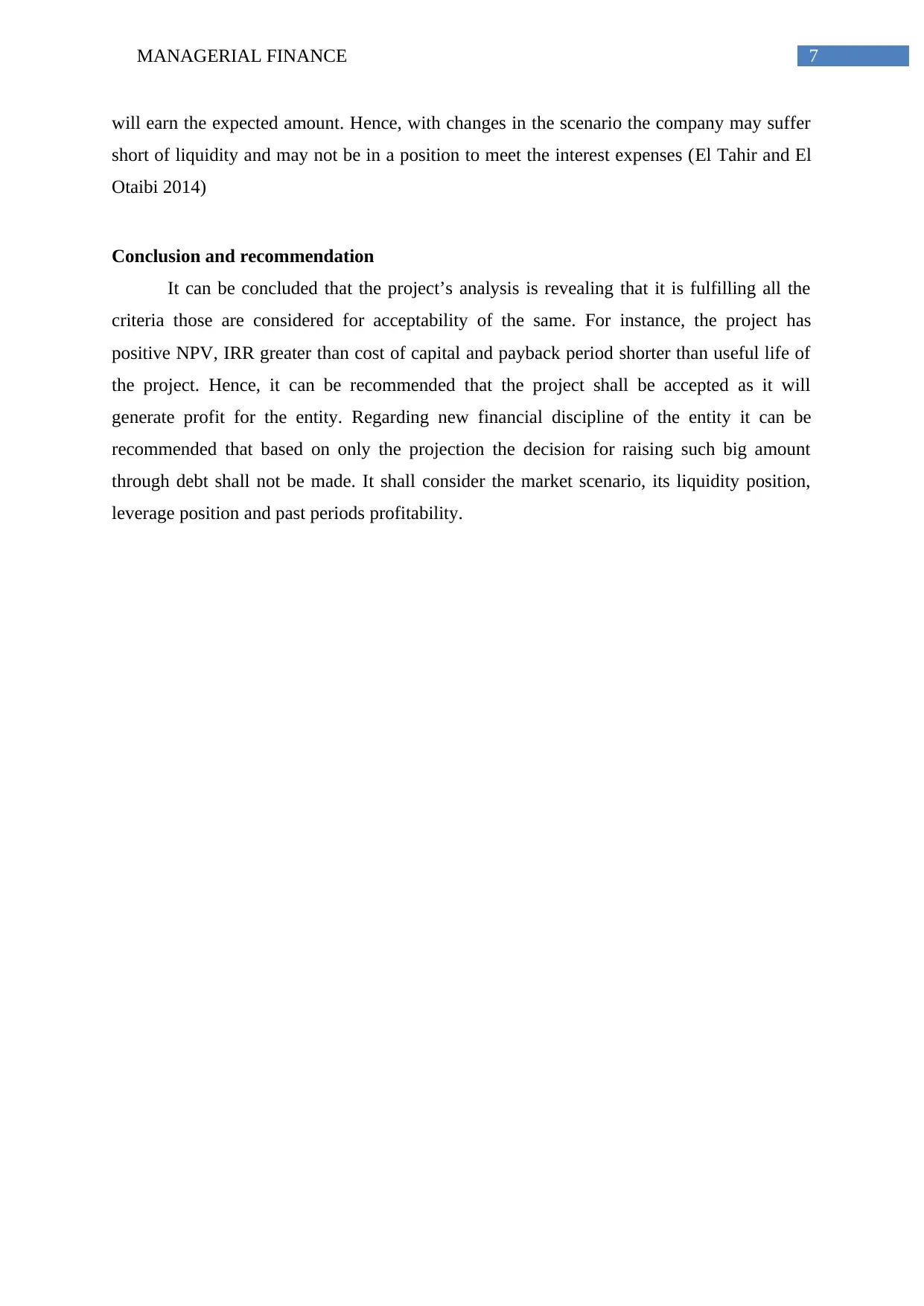
7MANAGERIAL FINANCE
will earn the expected amount. Hence, with changes in the scenario the company may suffer
short of liquidity and may not be in a position to meet the interest expenses (El Tahir and El
Otaibi 2014)
Conclusion and recommendation
It can be concluded that the project’s analysis is revealing that it is fulfilling all the
criteria those are considered for acceptability of the same. For instance, the project has
positive NPV, IRR greater than cost of capital and payback period shorter than useful life of
the project. Hence, it can be recommended that the project shall be accepted as it will
generate profit for the entity. Regarding new financial discipline of the entity it can be
recommended that based on only the projection the decision for raising such big amount
through debt shall not be made. It shall consider the market scenario, its liquidity position,
leverage position and past periods profitability.
will earn the expected amount. Hence, with changes in the scenario the company may suffer
short of liquidity and may not be in a position to meet the interest expenses (El Tahir and El
Otaibi 2014)
Conclusion and recommendation
It can be concluded that the project’s analysis is revealing that it is fulfilling all the
criteria those are considered for acceptability of the same. For instance, the project has
positive NPV, IRR greater than cost of capital and payback period shorter than useful life of
the project. Hence, it can be recommended that the project shall be accepted as it will
generate profit for the entity. Regarding new financial discipline of the entity it can be
recommended that based on only the projection the decision for raising such big amount
through debt shall not be made. It shall consider the market scenario, its liquidity position,
leverage position and past periods profitability.

8MANAGERIAL FINANCE
Reference
Campani, C.H., 2014. On the Rate of Return and Valuation of Non-Conventional
Projects. Business and Management Review, 3(12), pp.01-06.
El Tahir, Y. and El Otaibi, D., 2014. Internal Rate of Return: A suggested alternative formula
and its macroeconomics implications. Journal of American Science, 10(11), pp.216-221.
Gorshkov, A.S., Vatin, N.I., Rymkevich, P.P. and Kydrevich, O.O., 2018. Payback period of
investments in energy saving. Magazine of Civil Engineering, 78(2).
Hopkinson, M., 2017. Net Present value and risk modelling for projects. Routledge.
Levy, H., 2015. Stochastic dominance: Investment decision making under uncertainty.
Springer.
Leyman, P. and Vanhoucke, M., 2016. Payment models and net present value optimization
for resource-constrained project scheduling. Computers & Industrial Engineering, 91,
pp.139-153.
Magni, C.A., 2016. Capital depreciation and the underdetermination of rate of return: A
unifying perspective. Journal of Mathematical Economics, 67, pp.54-79.
Qiu, Y., Wang, Y.D. and Wang, J., 2015. Implied discount rate and payback threshold of
energy efficiency investment in the industrial sector. Applied Economics, 47(21), pp.2218-
2233.
Wiesemann, W. and Kuhn, D., 2015. The stochastic time-constrained net present value
problem. In Handbook on project management and scheduling vol. 2 (pp. 753-780). Springer,
Cham.
Reference
Campani, C.H., 2014. On the Rate of Return and Valuation of Non-Conventional
Projects. Business and Management Review, 3(12), pp.01-06.
El Tahir, Y. and El Otaibi, D., 2014. Internal Rate of Return: A suggested alternative formula
and its macroeconomics implications. Journal of American Science, 10(11), pp.216-221.
Gorshkov, A.S., Vatin, N.I., Rymkevich, P.P. and Kydrevich, O.O., 2018. Payback period of
investments in energy saving. Magazine of Civil Engineering, 78(2).
Hopkinson, M., 2017. Net Present value and risk modelling for projects. Routledge.
Levy, H., 2015. Stochastic dominance: Investment decision making under uncertainty.
Springer.
Leyman, P. and Vanhoucke, M., 2016. Payment models and net present value optimization
for resource-constrained project scheduling. Computers & Industrial Engineering, 91,
pp.139-153.
Magni, C.A., 2016. Capital depreciation and the underdetermination of rate of return: A
unifying perspective. Journal of Mathematical Economics, 67, pp.54-79.
Qiu, Y., Wang, Y.D. and Wang, J., 2015. Implied discount rate and payback threshold of
energy efficiency investment in the industrial sector. Applied Economics, 47(21), pp.2218-
2233.
Wiesemann, W. and Kuhn, D., 2015. The stochastic time-constrained net present value
problem. In Handbook on project management and scheduling vol. 2 (pp. 753-780). Springer,
Cham.
⊘ This is a preview!⊘
Do you want full access?
Subscribe today to unlock all pages.

Trusted by 1+ million students worldwide
1 out of 9
Related Documents
Your All-in-One AI-Powered Toolkit for Academic Success.
+13062052269
info@desklib.com
Available 24*7 on WhatsApp / Email
![[object Object]](/_next/static/media/star-bottom.7253800d.svg)
Unlock your academic potential
Copyright © 2020–2025 A2Z Services. All Rights Reserved. Developed and managed by ZUCOL.





